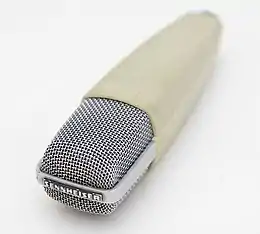Sennheiser MD 421
The Sennheiser MD 421 is a German cardioid dynamic microphone, widely used for speech in broadcasting and for music in live concerts and the recording studio. Introduced in 1960, the internal large-diaphragm transducer element of the MD 421 is still produced unchanged by Sennheiser. The MD 421 is considered a classic, an industry standard. More than 500,000 units have been sold.[1][2]

Properties

With a diaphragm diameter of 27 millimeters (1.1 in), the MD 421 is classified as a large-diaphragm microphone. Its wide frequency response (30–17,000 Hz ± 3 dB) exceeded the former Hi-Fi standard and came close to the performance of condenser microphones. The compact design of the MD421 transducer system was novel at the time, because directional pickup patterns had only been achieved by adding sound entry ports to the rear of the element (for instance, the Electro-Voice "variable-D system" with a row of ports in the handle.) Microphones with sound-shaping ports could only be held in the hand to a limited extent without the directional effect deteriorating. The MD 421 offered a smooth, closed plastic housing without ports, retaining its directional pickup pattern no matter how it was held.
Another special technical feature of the MD 421 is the hum compensation coil: It is wired in opposite polarity to the coil of the converter system. Low-frequency interference fields common to both coils are canceled out.
All MD 421s with European Kleintuchel or American XLR connectors have a knurled plastic ring between the housing and the connector, with which an adjustable inductive high-pass filter (roll-off filter) can be operated. The "S" (speech) position attenuates the transmission of low frequencies, and the "M" (music) position allows the microphone's full response.[3] The intermediate positions of this filter have been provided with a detent mechanism and markings since the 1970s.
History

Sennheiser developed the omnidirectional MD 21 model in 1953, for electronic news-gathering. The "MD" stood for mikrofon dynamische (dynamic microphone).[1] At the end of the 1950s, Fritz Sennheiser directed engineers Paul-Friedrich Warning and Johann-Friedrich Fischer to develop a new microphone. In 1960, the MD 421 was introduced with a directional pickup pattern, advertised by the manufacturer as a studio microphone. The light-colored body of the MD 421 was made out of a DuPont polyoxymethylene compound sold as Delrin. Later versions of the MD 421 were molded in black composite.[1]
Since its introduction in 1960, the MD 421 has established itself in almost all areas of professional sound technology, especially radio and television transmission technology as well as public address technology (PA). In addition to its sonic advantages, the microphone also achieved success thanks to the "music / speech filter" mentioned above. This high-pass filter has proven itself both when used as a vocal microphone (suppression of the proximity effect and plosives) and when broadcasting and recording outside to reduce wind noise. Handling noises and low-frequency street noise have been effectively reduced.
The characteristic shape of the MD 421 was part of the appearance of countless press conferences, political speeches and television reports well into the 1990s. In 1971, Sennheiser introduced another dynamic microphone but with a very long metal grille: the Sennheiser MD 441, which became another classic.
In 2010, the MD 421 was inducted into the TEC Awards TECnology Hall of Fame.[4]
Use

The microphone is popular with recording engineers, used in the production of all genres of music. The MD 421 is primarily used for drums, guitar amplifiers, woodwinds, brass and percussion instruments.[1] It is known for its almost linear frequency response in the bass range up to 1,000 Hz. Above that, the microphone exhibits a smooth increase in upper mid-range frequencies important for intelligibility.
In 1966, Udo Jürgens won the Eurovision Song Contest, singing the song "Merci, Chérie" into an MD 421. By 1971, the contest was almost entirely performed on MD 421 microphones. The Concert for Bangladesh by George Harrison included many MD 421s.
As a large-element dynamic microphone, it has slower impulse response and less resolution in higher frequencies compared to condenser microphones, and is therefore less suitable as the main microphone to record an orchestra, or as the overhead microphone for a drum kit, to capture the fast transients of cymbals. But it excels at its intended job: Jazz guitarist Brian Tarquin referred to the ubiquitous American Shure SM57 when he described the MD 421 as "an SM57 on steroids... probably one of the most diverse mics ever made."[5]
Musical instruments

The MD 421 can withstand high sound pressure levels, and it can record a wide dynamic range. It is frequently used on the following musical sources:[6][7]
- Bass drum (kick drum)
- Floor tom
- Rack toms
- Cajón at the rear port[8]
- Conga, dumbek, bodhrán, tumba and other drums[9]
- Leslie speaker, lower section
- Trombone
- Trumpet
- Saxophone (all sizes)
- Flute
- Bass clarinet
- Guitar amplifier including bass guitar
- Vocals
Accessories
The available accessories for the MD 421 include a short microphone stand to be used atop tables (model name MZT) and a windscreen (MZW) to cut wind noise; early windscreens were made of nylon and later ones of polyurethane foam. A shock-mount microphone clip (MZS) provides greater isolation for heavy vibrations that might be carried through the microphone body.
The standard-issue microphone clip (MZA) is a quick-change device that latches into a groove on the housing to hold the microphone upright. (Due to its unusual shape, the MD 421 cannot be used with commonly available microphone clips.) The supplied microphone clip is pushed into a groove on the underside of the microphone and mechanically locked with a quick-release button. Many users have complained about the tendency of the supplied microphone clip to let go of the microphone, allowing it to drop, especially when adjusted quickly for instrumental solos, or when mounted pointing downward at tom-tom drums. Various solutions suggested by engineers include ways to prevent movement of the quick-release mechanism, for instance with a small zip tie.[10] Others have fabricated a larger plastic clip that works more like a standard microphone clip.
Versions

The microphone was produced in the following versions:
- MD 421–2 with light gray / silver-colored housing and balanced, 3-pin threaded connector wired according to DIN 41624.
- MD 421-N with light gray / silver-colored housing, 5-step rotary switch for stepped bass reduction and balanced, 3-pin threaded connector wired according to DIN 41524.
- MD 421 de Luxe with black housing, gold-colored grille, same internally as the MD 421-N.
- MD 421-HL with light gray / silver-colored housing and balanced/unbalanced connector wired according to DIN 41524, and a transformer for optional high-impedance connection to consumer tape recorders.
- MD 421-U has a black housing and balanced XLR connector. The 421 U4 and U5 versions differ in the thread on the removable microphone clip. Version U4 has an interchangeable thread, while U5 has a thread with a fixed 3/8-inch dimension for the American market.
- MD 421 II introduced in 2002. Essentially the same as MD 421-U but manufactured with more economical processes.[11]
- MD 521 "Blackfire": black housing and balanced XLR connection, but without the 5-step bass cut switch.
See also
References
- Petersen, George (October 10, 2020). "Sennheiser Celebrates 60 Years of the MD 421". FOH. Retrieved July 24, 2021.
- Inglis, Sam (March 2021). "Legendary Studio Mics You Can Still Buy New". Sound on Sound. Retrieved July 22, 2021.
- Shaw, Dan (March 24, 2020). "Always listening: 75 years of Sennheiser microphones". Happy. Retrieved July 22, 2021.
- Petersen, George (2010). "2010 TECnology Hall of Fame". TEC Awards. Retrieved July 24, 2021.
- Tarquin, Brian (2015). The Insider's Guide to Home Recording. Simon and Schuster. ISBN 9781621534501. Page 8 of Chapter 4.
- Bartlett, Bruce; Bartlett, Jenny (2013). On Location Recording Techniques. Taylor & Francis. ISBN 9781136119019.
- Ross, Bob. "Miking Brass and Winds". Recording Mag. Music Maker. Retrieved July 23, 2021.
- Prasad, Baba (April 16, 2018). "How to Record the Cajon at Home Recording Studio?". The Score magazine. Retrieved July 24, 2021.
- Stackpole, Karen. "How To Mike Percussion On Stage". Drum Magazine. Retrieved July 24, 2021.
- Matt (December 4, 2017). "The Mic Clip from Hell: Hacking the Sennheiser MD421". Undisclosed Location Studios. Arlington, Virginia. Retrieved July 23, 2021.
- Robjohns, Hugh (November 2002). "Q&A November 2002". Sound on Sound.
External links
- Manufacturer's webpage of the Sennheiser MD 421 II (US English)